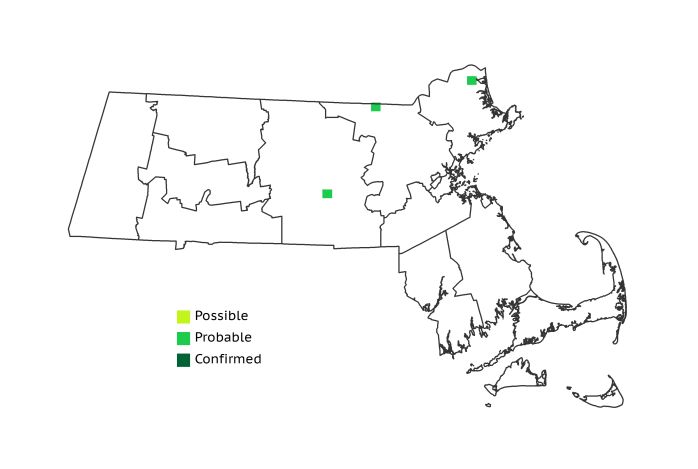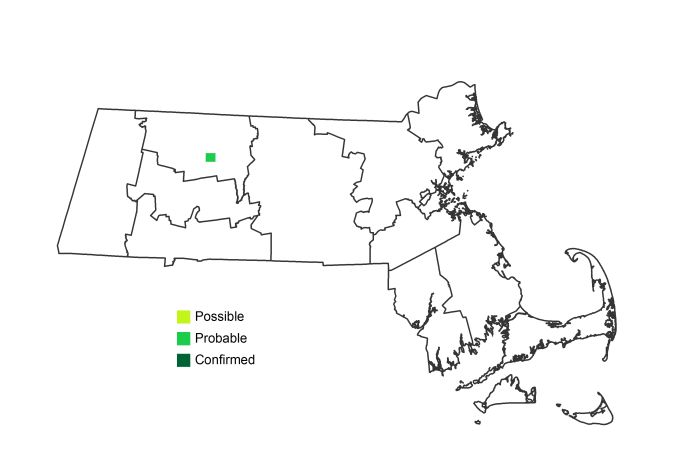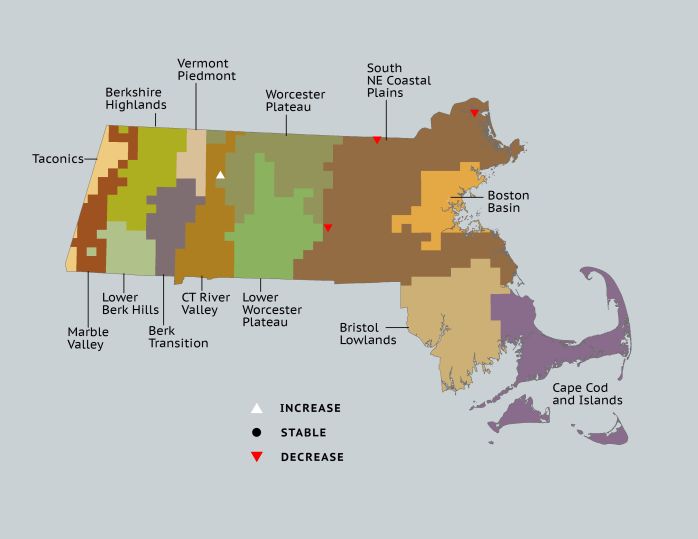Find a Bird
Henslow's Sparrow
Ammodramus henslowii

Very local, trend not established
Conservation action urgent
Endangered Species
“Let us first see what the result may be, and then let us speculate afterwards upon what that result may teach us.” – Rev. John Stevens Henslow
The Henslow’s Sparrow, which Audubon named for the renowned English naturalist John Stevens Henslow, is seldom seen in Massachusetts. For one thing, the species is shy and reclusive, preferring to hide low among the grasses rather than flush and fly when approached. Even without this quirk of behavior, the species is seldom seen because very few even pass through the state on migration. It has become extremely rare in Massachusetts, and it is unlikely that this species still breeds in the Commonwealth in sustainable numbers.
Historic Status
The Henslow’s Bunting was first identified and named by John James Audubon in 1829, but Massachusetts observers did not leave a record of its appearance in our state until the 1860s, when Charles Johnson Maynard claimed to have shot two “in a wet meadow” on May 10, 1867 (Maynard 1870). Interestingly, in his book The Land-Birds and Game-Birds of New England, Henry Davis Minot noted that “this species was at first recorded in this State as Bachman’s Finch…an error afterwards corrected,” (Minot 1877). Regardless, the species remained rare and local, teetering on the eastern edge of its range. Forbush called it a “rare to common local summer resident” (Forbush 1929), but a major decline apparently began after 1935 (Petersen & Meservey 2003).
Atlas 1 Distribution
The now state Endangered Henslow’s Sparrow has a well-deserved reputation for secrecy, and its status as a definite breeder in the Commonwealth was indeterminate during Atlas 1. Certainly, the 3 Probable blocks in the Coastal Plains suggested that small numbers of Henslow’s Sparrows might have persisted as breeders in the state, but the amount of grassland habitat suitable for use by this species was undeniably far less than in earlier years. Gone were the acres upon acres of wet hay meadows and pasture that so admirably mimicked the tallgrass prairie habitat that this species favors in other parts of its range. Instead, the sparrows were forced to seek out remnant pieces of still-active farmland or airfields to make their living, and by the time of Atlas 1 it seemed likely that the Henslow’s Sparrow had ceased to be a regular breeder in Massachusetts.
Atlas 2 Distribution and Change
In 1994, during the inter-Atlas period, amazingly a pair of Henslow’s Sparrows was Confirmed to be nesting in Lincoln, Massachusetts. This isolated instance offered the last evidence of breeding activity in the state to date. Three decades after the close of the first Atlas, the species stood on the absolute brink of extirpation from Massachusetts as a breeder. The 3 previous Probable blocks proved to be devoid of Henslow’s Sparrows in Atlas 2, and only one new occurrence was documented in the Connecticut River Valley.
Atlas 1 Map

Atlas 2 Map

Atlas Change Map

Ecoregion Data
Atlas 1 | Atlas 2 | Change | ||||||
Ecoregion | # Blocks | % Blocks | % of Range | # Blocks | % Blocks | % of Range | Change in # Blocks | Change in % Blocks |
Taconic Mountains | 0 | 0.0 | 0.0 | 0 | 0.0 | 0.0 | 0 | 0.0 |
Marble Valleys/Housatonic Valley | 0 | 0.0 | 0.0 | 0 | 0.0 | 0.0 | 0 | 0.0 |
Berkshire Highlands | 0 | 0.0 | 0.0 | 0 | 0.0 | 0.0 | 0 | 0.0 |
Lower Berkshire Hills | 0 | 0.0 | 0.0 | 0 | 0.0 | 0.0 | 0 | 0.0 |
Vermont Piedmont | 0 | 0.0 | 0.0 | 0 | 0.0 | 0.0 | 0 | 0.0 |
Berkshire Transition | 0 | 0.0 | 0.0 | 0 | 0.0 | 0.0 | 0 | 0.0 |
Connecticut River Valley | 0 | 0.0 | 0.0 | 1 | 1.5 | 100.0 | 1 | 2.1 |
Worcester Plateau | 0 | 0.0 | 0.0 | 0 | 0.0 | 0.0 | 0 | 0.0 |
Lower Worcester Plateau | 0 | 0.0 | 0.0 | 0 | 0.0 | 0.0 | 0 | 0.0 |
S. New England Coastal Plains and Hills | 3 | 1.1 | 100.0 | 0 | 0.0 | 0.0 | -3 | -1.3 |
Boston Basin | 0 | 0.0 | 0.0 | 0 | 0.0 | 0.0 | 0 | 0.0 |
Bristol and Narragansett Lowlands | 0 | 0.0 | 0.0 | 0 | 0.0 | 0.0 | 0 | 0.0 |
Cape Cod and Islands | 0 | 0.0 | 0.0 | 0 | 0.0 | 0.0 | 0 | 0.0 |
Statewide Total | 3 | 0.3 | 100.0 | 1 | 0.1 | 100.0 | -2 | -0.2 |



